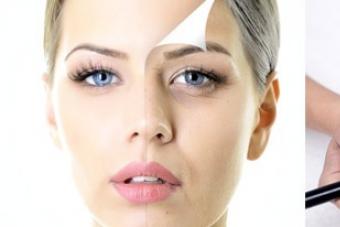1. Quilted layers of padding polyester.
First, I lay several layers of padding polyester or its trimmings between 2 layers of rough fabric and quilt it in a random order. You need to take a piece 4-5 cm larger on each side (do not cut out the parts right away. Just take a piece).
Next, on the already quilted blank, you can place the bottom detail of the main material - be it leather, bag fabric, or a knitted bottom. Now you can configure it.
A leather or fabric piece can be customized by stitching into a medium-sized checkered pattern. It is better to sew a knitted piece along the rows of loops.
After stitching, cut off the excess along the edges.
Pros:
- when applying a sufficient number of layers of padding polyester, the bottom becomes rigid, but at the same time flexible and not brittle.
- inexpensive method, you can use scraps of any insulation
Minuses:
- fairly long production time
- it is impossible to make the bottom oak
2. Foam rubber (aka polyurethane foam).
If there are foam rubber of different thicknesses on sale, you can choose for yourself. It is advisable to use a height of up to 2 cm. Here we simply stitch the bottom onto foam rubber with a quilt, for example, in a cage. We also get a convex texture.
Pros: ease of manufacture.
Minuses:
- the material is not very cheap
- the bottom is compacted, but soft.
3. Izolon.
Sold in construction departments. Looks like very dense foam rubber. By nature it is a foamed and compacted gas. It comes in different thicknesses and densities. The thinnest option is the so-called laminate underlay. Here you need to be careful - the material must be flexible and should not break (there are brittle types of isolon).
Pros:
- the hardest version of isolon is used in industrial sewing of bags, provides super-rigidity of the bottom
- despite the rigidity, the needle puncture is good.
Minuses:
- the most expensive option of those listed.
4. Fleece is very flexible and remains soft even after repeated stitching.
5. Bags made of artificial leather and not only if you want them to keep their shape, you need to treat them with cedar. This is when an edging with a nylon vein is sewn into the seam. Very tough. I do it myself. I buy fishing line for trimmer 2-2.5 mm. And just as they make the edging themselves, wrapping the lace with the necessary fabric, I also wrap this fishing line with leatherette or fabric and make the edging with a foot for a hidden zipper. I don’t know if I explained it clearly... At least in the bag sewing industry, that’s exactly what they do. Well, among other things, the parts are duplicated with foam, that is, with a backing for the laminate (15-25 rubles per meter).
It turns out to sew bags of all sorts of fancy shapes. In the form of a leaf, for example, a heart, etc. And there are no problems with the shape.
6. We went through all the modern materials and completely forgot the classic table oilcloth. I’ve been sewing bags for myself for a very long time and haven’t bought a single one ready-made for almost 20 years, so I duplicate all the bags with regular oilcloth. The bag turns out to be three-layered - on the outside there is usually raincoat fabric (nylon), then oilcloth with the right side out (so that the contents do not get wet) and then the lining. Practice has shown that this option holds its shape perfectly, withstands any weather and lasts 5-7 years of everyday wear.
Oilcloth cannot be quilted, because Moisture (snow, rain) will enter through the stitching holes. I first sew each part of the bag separately - I sew the inner pockets first, and then the outer ones. When everything is ready, I collect it.
7. I make handles for bags like this: I cut a strip of old worn jeans (I’m already running out of 2 pants), fold them into 2 layers, wash them and iron them. Then I wrap it with the outer fabric from which the bag is made. I wash and iron again. Next, I stitch from 2 sides at a distance of 0.5 paws from the edge. The handle is very durable, holds its shape well and is moderately flexible. Now as for washing. I wash all my shopping bags in a basin with hot water and powder. Non-household ones, I simply wash the top with a washcloth and the same washing powder and rinse directly under the tap. Oilcloth is a very durable material.
Bags and backpacks perform one simple function - they carry things. This means that the fabric for sewing products must be extremely durable and strong, as well as easy to care for, because it is very often used outdoors, in any weather.
To create bags and backpacks, natural and synthetic fabrics are used, as well as a huge amount of accessories and decor. Let's take a closer look at materials for exterior decoration and decoration.
A few words about bags
Traditionally, a bag is a soft container for carrying various items.
They are worn on the shoulder, in the hands, as well as on the belt and even on the arm. The structure can be reinforced with a hard bottom and rigid walls. Handles come in a variety of varieties - leather, wicker, wood, short and long.
Both men and women carry bags. This is a fairly general concept that can include suitcases, briefcases, clutches, traveling bags and string bags. The bag comes in:
- volumetric (economic);
- saddle (shoulder);
- road;
- bracelet bag;
- beach;
- field;
- bag.
These are not all varieties. Obviously, a huge amount of materials are used to sew all kinds of bags.
Fun fact: Amsterdam has a Bag Museum with over 3,500 items on display. Many of them have survived from the 16th century.
A little about backpacks and satchels
 Travel backpacks
Travel backpacks A backpack is just a type of bag, its shoulder version. Typically, a backpack has one or two slanted straps that go over the shoulders. Your hands remain free. A satchel, unlike a backpack, has straight straps.
The modern backpack, which is so loved by tourists and simply practical people, has evolved from an army backpack. The first models were made of tarpaulin, that is, dense fire-resistant and water-repellent canvas. The capacity of the backpack ranges from 40 to 70 liters (there are also larger sizes). They also differ in design (soft, hard and semi-rigid, so-called anatomical).
Thematic varieties of backpacks:
- mountaineering;
- bicycle;
- military;
- urban;
- tourist.
The backpack must be extremely durable, because you can carry a much larger load on your own shoulders than in your hands, as is the case with a bag. That is why backpack fabrics are very dense, wear-resistant, often impregnated with protective compounds against moisture and fire.
Material for bags and backpacks
Let's take a closer look at the materials from which bags and backpacks are made.
Gabardine
Made from the following materials:
- natural wool;
- synthetic fibers;
- lurex, silver and gold threads.
Positive qualities of the fabric:
- density and strength;
- wear resistance;
- dimensional stability;
- decorativeness.
Typically, tapestry fabrics do not require complex care - modern fabrics are impregnated with protective compounds. It is best to clean the bag dry. If the contamination is persistent, wash only the area that requires care. Tapestries are protected from moisture and direct sunlight.
Denim
This material is called . The victorious history of denim began precisely when entrepreneur Levi Strauss came up with durable pants for workers - jeans. Any type of denim always contains cotton. Threads for future fabric are twisted - they become stronger. The fabric is made with a twill weave, which gives the material a ribbed texture and diagonal pattern.
 Denim bags
Denim bags Positive features of denim:
- versatility (they sew both bags and backpacks);
- wear resistance;
- does not allow dust to pass through;
- not electrified;
- attractive appearance.
Over time, denim products fade and wear out. These disadvantages can be explained by the large presence of cotton in the composition. Among other denim fabrics, denim can be recognized by its bright front side and light back.
Suede
Fabric is an artificial substitute for a similar type of natural leather. It is considered a humane and environmentally friendly material. The main feature is the soft short pile on the back and face of the fabric. Suede is made from cotton and silk.
Fabric characteristics:
- dimensional stability;
- wear resistance;
- beauty;
- the fabric is very pleasant to the touch;
- affordable price.
Most often, women's bags are made from suede. The material looks very rich, aesthetically pleasing and rarely needs additional decoration.
Canvas
The material is made of two layers: top (polyester/) and bottom (cotton). Thanks to complex production technology and thickness, the material is incredibly durable and dense. Externally, canvas resembles canvas.
Advantages:
- softness;
- wear resistance;
- dimensional stability;
- water repellency.
Backpacks and durable bags, as well as tents and awnings, are made from canvas.
Cordura
 Cordura resembles canvas
Cordura resembles canvas Cordura is considered a type of nylon. The main difference is the special structure of the fiber, which is cut and additionally twisted, which increases the strength of the material. The fabric is very thick, durable, often coated with polyurethane and water-repellent. Cordura is four times more durable than nylon.
Other fabric features:
- reliability;
- abrasion resistance;
- repels water and dirt.
However, the material is heavy and expensive. In the cold, cordura “dumbs” and becomes brittle. It is used for sewing special bags and backpacks for professional hunters, fishermen, and tourists.
Lake
 Lacquer bags are very popular
Lacquer bags are very popular Laque is an artificial leather with a glossy shiny surface. A special varnish coating is applied to a nylon base, sometimes with the addition of other materials. Not only bags are made from lacquer, but also skirts, dresses, gloves, and furniture upholstery.
Advantages of the material:
- elasticity;
- dimensional stability;
- wide selection of colors and textures;
- wear resistance.
Varnish does not require specific care. Clean the material with a soapy sponge, and then remove the water with a dry cloth.
Nylon
The synthetic polymer material was developed by the chemical company DuPont at the beginning of the twentieth century. To obtain fiber, polymers are melted and stretched. When frozen, they retain strength and elasticity.
A huge number of types of clothing are made from nylon - underwear, stockings, jackets, covers and backpacks, mainly for tourism and sports. Material Features:
- high wear resistance;
- ease;
- strength;
- dimensional stability;
- variety of colors, fabric holds color well;
- affordable price.
Nylon does not absorb moisture, deteriorates due to chlorine and is highly electrified. A nylon backpack is a durable, reliable product that will show its best side more than once during a hike.
Oxford
 Oxford bags
Oxford bags Synthetic fabric, which is made from nylon and polyester with durable matting weaving - “two threads through two threads.” To protect from wind and moisture, they are coated with colorless polyurethane. Thanks to nylon, the fabric does not dry out and reacts poorly to chemicals. This is an ideal fabric for travel backpacks.
Advantages of the material:
- elasticity;
- strength;
- moisture resistance;
- affordable price.
Unfortunately, oxford is deformed when exposed to strong heat, so the products are stored away from radiators and not placed near a fire. Oxford also accumulates static electricity.
Twill
Smooth fabric with a diagonal weave pattern. - This is a twill fabric, that is, the warp threads smoothly bend around the weft, forming a silky fabric reminiscent of satin. The basic materials for making twill are wool and silk. It is also possible to add natural cotton and synthetics (polyester, for example).
Positive features of twill:
- retains its shape perfectly;
- color fastness (does not fade or fade);
- ease of care;
- aesthetic appearance.
Twill is also used to make things for which strength is the main parameter (raincoats, workwear, overalls).
Eco leather
 Eco leather is a good material for bags
Eco leather is a good material for bags An artificial substitute for natural leather. Typically consists of two layers - a woven textile fabric and a polymer top layer. color, and also give it a texture indistinguishable from natural.
For the base use:
- cotton;
- polyester.
Main characteristics:
- strength;
- elasticity;
- hypoallergenic;
- breathability;
- dimensional stability;
- ease of care;
- the outer layer does not absorb water and dirt;
- Doesn't get rough in the cold.
To clean light dirt from eco-leather, it is usually enough to wipe the product with soapy water and wipe dry. Animals are not used to make the material, so eco-leather is humane and environmentally friendly.
Lining fabrics
Lining fabrics are needed to hide rough seams inside the bag, as well as to create additional pockets and sections. Most often, a combination of synthetic and natural fibers is used, because it is chemical materials that give the product special strength and moisture resistance.
Lining fabrics are also needed for outerwear, skirts, dresses and tracksuits.
- Atlas - smooth material with a silky sheen. It is made by special, “satin” weaving of threads - the weft is hidden under the warp, covering it with a continuous layer. Initially, the fabric was made only from natural silk. Now the presence of synthetics is acceptable, the presence of which can be clarified on the label. Advantages: density, reliability, wear resistance, hygiene. It also holds its shape well and does not electrify. Absorbs moisture, and therefore dirt. That is why the material is not used for bulky shopping bags and backpacks. The satin lining is suitable for miniature clutches.
- Viscose- artificial matter, which is obtained by processing cellulose. Viscose is considered a more reliable material than satin. Advantages of the fabric: strength and hygroscopicity, it glides gently and does not electrify. The price is very affordable. The material is used for light summer bags.
- Cupro- the material looks almost the same as natural silk, but is made from cellulose and natural cotton. Features: strength, softness, elasticity, smoothness. does not wrinkle at all. It is considered the most expensive fabric made from cellulose.
- Polyester- universal synthetic fabric of polyester origin. The material is very durable and easy to clean. In addition, the fabric does not wrinkle, does not accumulate static electricity, and is also resistant to moisture. Polyester is not hygroscopic, so it does not absorb dirt well.
- Satin- a shiny material made from silk and cotton threads. It resembles satin, but the surface of the satin is formed by weft threads, not warps. This is a reliable and dense material. Satin does not wrinkle or wear out.
- Net– an interesting fabric with large cells between the warp and weft threads. Typically used for decorating backpacks and external patch pockets, as well as for internal zoning. Synthetic ones are most often used.
- Taffeta– rigid, shape-resistant fabric that does not wrinkle. The front side shimmers softly. made from silk, cotton and synthetic threads.
The lining helps to maintain a decent appearance of the product for a long time. Also, thanks to the lining, internal fittings are attached - fasteners, zippers. It is from the lining fabric that partitions and secret pockets inside bags are made.
It is important that the lining fabric is smooth and durable and does not fray (otherwise, soon the inside of the bag will look like a picturesque fringe).
Handles, clasps and lining are the elements that most often cause a bag to be repaired. That is why it is important to choose a product not only by external features, but also by the quality of its internal design.
Hello everyone who came today to learn the little secrets of my skill.
Today I want to tell you what additional duplicating materials I use to seal linings, leather, bottoms, handles....
If someone naively believes that by buying just a piece of leather, he will sew a bag, then he is mistaken. In addition to leather, the work uses a variety of additional materials that strengthen the leather (preventing it from stretching), allow it to be made denser, if required by the model, etc.
I think that these little secrets will be useful for novice masters.
But let me start with why I decided to write this material. The fact is that I came across my mother’s bag, with which she went to college 50 years ago. The bag was leather, on the stamp was the logo of a Moscow tannery, model number and... price (10 rubles 70 kopecks).
It’s hard to guess now whether it was expensive. But since the bag was leather, I think that my mother was not the latest fashionista.
So, after gutting the bag, I discovered what used to be an additional material in production for the manufacture of leather products.
And this is what was discovered!!!
Ordinary cardboard and, surprisingly,... batting.
I think that back then, even in production, people were forced to make bags.
Now our industry has stepped far forward and even self-taught craftsmen can take advantage of a huge range of additional materials in the manufacture of bags.
I'll start with the materials I use to seal all my linings.
I use mostly cotton fabric for linings. Natural weaves have better contact with adhesive duplicating materials. Synthetics melt and deform.
Why do I strengthen the linings? The fact is that such a lining not only holds its shape well, but also maintains the shape of the bag if the leather is not thick enough.
I even glue the fabric I use on the inside and outside pockets of my bag.
1. Thin adhesive for pockets. You can even use non-woven fabric (paper backing with adhesive).


2. Thick adhesive fabric on a woven basis. Tough enough. I buy it on Taobao.
With this adhesive lining it becomes not plump, but very rigid. When turned inside out, it does not break!!!

3. To make the lining thick and voluminous, I use either a non-woven fabric with an adhesive base, or
Non-woven voluminous adhesive one-sided
I also buy by the meter in China. , but can also be found at
Depending on the thickness, different results come out.
4. If I need a less puffy lining, I use rolled synthetic padding and iron it to the fabric using adhesive web. Only then do I cut out the lining piece. And not vice versa
As a rule, I buy in bulk immediately

5. I also have thick adhesive tape in my arsenal. I use it to strengthen my arms. Sold in sewing stores. Used for sewing trousers.

That's how much adhesive materials are there just for the lining.))))
Now I’ll tell you what I use to tighten my skin.
1. I really liked the adhesive jersey for leather. It is on a knitted base. And after sizing, the skin does not become prickly, but remains elastic.
In addition, it has excellent glue, which melts and sticks to the skin at a sufficiently low temperature. After all, you can’t expose your skin to ironing for a long time. I buy in Moscow in
Speranza

2. I took it there too A very interesting seal for the skin. This is a melted glue that is applied in a thin layer to paper. You apply the adhesive side to the skin and stroke it over the paper. Let it cool completely. After that you remove the paper. And a layer of frozen glue remains on the skin, which completely allows the skin to move plastically in different directions. The cut of such thickened skin is simply magnificent. It can be left open in products.
3. To seal the bottom I use foam rubber
The photo above shows the materials I use to duplicate the leather parts of the bag.
I write about this in the next (ninth) issue of the newsletter.
http://subscribe.ru/catalog/culture.hobby.sumkiostroglyad
Above in the photo is foam rubber (there is adhesive and non-adhesive).
Below and to the right is isolon (it can also be adhesive or non-adhesive, I use adhesive).
Below, pink, leather goods cardboard.
At the very bottom - black, spunbond (available in different thicknesses).
All this is sold at “MiK” on Elizarovskaya, and cardboard is sold nearby at “Sperantsa”.
Using my bags as an example, I’ll tell you in what cases I use this or that duplicating material.
Foam rubber.I use it very rarely, since it is only suitable for thin and soft skin, and I very rarely use that. It is better to take a non-adhesive one, since it is unlikely to be possible to glue it evenly over the entire surface using an iron. Instead of using glue, I simply sew it around the perimeter of the part at a distance of 3-5 mm from the edge so that it holds, and then it will fit into the allowances. I duplicated the “Blue Leaves” and “Dragon” bags with foam rubber. By the way, they are made according to the same pattern, only one of them has seams on the sides, and the other has seams in the center.


Spunbond.This material comes in black and white, of different thicknesses. I use black spunbond 80-100 microns thick to seal some parts of the bag and a denser 130-150 microns to duplicate the front and back walls of the bag. It is also better not to glue it over the entire surface, but to fasten it around the perimeter. Well, or glue it with glue or double-sided tape, if this is, for example, a place where handles will be sewn to a bag, the walls of which do not need to be duplicated with anything. I also always make mock-ups of future bags from this material in order to check the correctness of the pattern and adjust it to what we need. I duplicated the “Bear on a Bicycle” bag with spunbond. Both her top and her bottom are made of patent leather, although the latter may have been unnecessary, but I wanted it to stand straight and not be askew. In the same way, I duplicated the details of the “Butterfly” handbag.

Izolon.It can also be adhesive or non-adhesive. I've only used glue so far. In 80% of bags I use this material, 2 mm thick, to duplicate parts. I cut out the part from isolon a little smaller than the leather part, since it should not get into the seam. Glue accumulates on the needle and the machine doesn’t like it. This is the only inconvenience. Basically, the material behaves well if the skin is suitable: dense enough, moderately stiff and in no way stretchy. Although you can try to glue isolon to the stretching one, the result is unpredictable. And it sticks like this: we peel off the protective layer from it and we are left with material in our hands, on one side of which there is a sticky layer. We glue it to the inside of the leather part. I used isolon in the Seahorse bag. I glued it separately to each part of the front and back walls, then sewed all the parts together... Of course, it’s easier when you can glue the isolon to the entire part of the front or back wall at once, but there I got a voluminous part between the parts - a vein covered in leather, so that this option was not suitable.
Leather goods cardboard.
This is wonderful material. Moderately flexible, moderately thick. Basically I compact the bottom with it. Sometimes in addition to isolon. Or I use it to seal a non-reversible clutch, such as “Black with a butterfly bow.” In general, cardboard is for products that do not need to be turned inside out. But if you just seal the bottom, you can turn it out. Or it happens that this cardboard bottom, lined with lining material, is made separately, and you can even take it out of the bag.
In a clutch made of fabric “Blue with a butterfly bow” I used simultaneously adhesive isolon and leather goods cardboard. I glued the isolon to the back of the fabric, and then stuck the cardboard into the almost finished bag. But maybe it would be possible to glue the isolon onto cardboard and stick such a part in at the end of working on the bag.
There are bags in which there are almost no need to seal anything. It depends on the model of the bag and on the correct leather. For example, a backpack that Artyom made in class. It is unlined. And we selected the skin so that it would look good even without any seals. We only duplicated the bottom. Skin. That is, we cut out two bottoms and glued them together with rubber glue. The bottom turned out to be quite dense, and it looks beautiful from the inside.
Look like that's it.
Next time I’ll write about... To be honest, I don’t know what yet. Most likely, this will be a bag pattern and a description of the work, but if not, then sorry, later. Everyone - fresh air, warm sea and an even tan.
P.S. We are still on vacation. Our enthusiasm for going to the sea twice a day has waned somewhat, so we go to the sea only once, in the late afternoon, and escape the unbearable heat of the day at home. Yesterday we had a big family picnic: we fried sausages on the seashore, ate watermelon and a lot of other food and, of course, swam until we were stunned! :)
Sealant is a special cushioning material used in garments to give them rigidity. When sewing "hard" and "semi-hard" bags, it is simply necessary so that the final product holds its shape and retains its beautiful appearance for a long time. It is located between the outer fabric and the lining and is not visible from the outside.
The seal can be glued to the parts of the bag and stitched, or it can be used as an insert without being secured with a machine seam. The bag seal must be able to withstand deformation loads well.
To collect a more complete list of seals, I conducted a survey among my readers and subscribers. I thank everyone who responded and wrote. I have included your valuable advice in this article.
I divide bag seals into two types:
— those that were originally intended for sewing production;
- “crazy hands” or “cunning need for invention” - materials that are intended for other purposes, but perfectly suited our tasks: to compact the bag, give it rigidity and the desired shape.
Adhesive seals for bags and backpacks.
This includes industrial sewing materials. They are made of a base (woven or non-woven) with an adhesive layer applied to it. The glue is applied in a continuous layer or dotted.
Adhesive seals make the fabric of the bag thicker and stiffer, so it holds its shape better.
Nonwoven
Non-woven material made from cellulose fibers with the addition of polyester. It's quite durable. Manufacturers claim that it does not stretch or tear. From my experience I can say that if you pull it diagonally, it still spreads a little. There are adhesive and non-adhesive. Adhesive coating – continuous and dotted. It is advisable to cover the interlining with a lining, because its surface may become disheveled over time and look unsightly.
From my own experience and the experience of other craftswomen, I will say that the service life, shape and appearance of the finished product depend on how well the interlining is glued. Unfortunately, there is no ideal recipe for the temperature and pressure of the iron, since interlining was initially produced for textile production, where special presses are used.
There is a type of non-woven fabric - thread-sewn. The non-woven fabric is quilted and due to this it becomes denser and stretches less.
Another type is voluminous non-woven fabric. This is a non-woven fabric made from cotton fibers. It looks like padding polyester, but has a denser structure.
Doublerin
A seal made from a fabric base, cotton or knitted. The adhesive layer is continuous and dotted. When cutting parts made from dublerin, you need to take into account the direction of the grain thread, just like on regular fabric.
Dublerin varies in density: from thin knitwear to thick cotton. It should be borne in mind that products made from dense dublerin are difficult to turn inside out. It gives rigidity and shape to finished products and protects them from stretching. It is also used to strengthen individual parts - pocket flaps, straps, etc.

Decoville
This is adhesive-based non-woven fabric made using new technology. It looks like light beige leather, about 2 mm thick. It does not wrinkle, does not crumble when cut, does not tear, bends easily and does not break. A product reinforced with decovil retains its shape well. It is used for sewing bags and belts. Suitable for cotton and synthetics.

Cobweb
Non-woven transparent material with glue applied on both sides. It consists of thin fibers with a sparse weave and really resembles a cobweb in appearance. Sold as a canvas or in a narrow strip.
It is used to connect two parts together, to secure appliques, loops or seams, and to process the bottom of a product. The web is more suitable as a way to briefly secure a part, because may come off after washing.
Bags made from faux or genuine leather usually don't wash, so a layer of cotton or other lining fabric can be attached using webbing to add rigidity and shape.
It is not recommended to use cobwebs on thin fabrics. It can be regular or paper based. The second option is considered better, because It has a mesh structure and is slightly stretchable.

Glue calico
This is a thick cotton fabric with a fairly large texture. The adhesive coating is continuous. It is used where the product needs to maintain a constant rigid shape - shirt collars, cuffs, etc. It is used on dense cotton fabrics. Sometimes calico is equated to adhesive dublerin, since both materials have a fabric base.

Sintepon
Thread stitching adhesive, also known as an amplifier for side fabric.
A soft non-woven fabric, quilted with parallel stitches for strength. Thickness 3-4 mm. There is a dense and loose variety.
Good for bags that need a non-rigid shape and volume. They strengthen the bottom and walls.
Quilted padding polyester.
You can quilt it yourself, or you can buy it ready-made. They are used to strengthen the bottom and walls of bags and backpacks. The parts are dense, but at the same time flexible. However, if you need to make a hard bottom, this material will not work. If you do the quilting yourself, it is a rather labor-intensive process.

Dot adhesive synthetic padding polyester.
It is thinner than, for example, thread-stitched. The dots are small and large. The first option is better, because larger connection area with the main part. Sintepon with large dots sticks worse and copes with its duties worse.


Proclamelin
The same applies to non-woven fabric. Made from viscose and nitron fibers. Keeps its shape well and does not stretch. It can be cut in any direction. Available in two types: adhesive and non-adhesive. It is used in the manufacture of hats, coats and individual items of clothing. It resembles non-woven fabric, but proclamelin feels denser to the touch.

Side seal
Non-woven material made from cotton fibers. The structure resembles felt. One of the sides is adhesive. It is a little similar to adhesive padding polyester, but, unlike it, it has a denser structure. When sewing small parts, it is not recommended to put the sealant into the seam, otherwise it will be too thick. Suitable for thick but not hard straps, bottoms and sides of bags. Gives products strength, soft shape and volume.

Non-adhesive seals for bags and backpacks.
Spunbond
Thin non-woven synthetic material made from melted polymers. Other names: covering material, agrofibre. It was originally created for the needs of the agricultural industry. They cover beds and greenhouses and make drainage systems. Spunbond is environmentally friendly and very durable. Now it is widely used in the clothing industry in the production of carpets, blankets and workwear. Available in different thicknesses and colors and even with foil coating. When sewing soft bags, it is used to shape the walls and bottom.
Batting and burlap
This is a non-woven fabric made of cotton or wool fibers joined together with a herringbone seam. It is well known to workers in the Soviet-era clothing industry. They were insulated with coats and fur coats. Keep in mind that batting is a fairly heavy material, and products made from it take a long time to dry after washing. It gives volume and soft shape to bags.
Technical felt
Material obtained by felting wool. It varies in thickness and amount of impurities in the composition. It is used in the shoe industry (insoles, felt boots, etc.), as room insulation, a cushioning layer to protect metal parts, sound-proofing material, etc. In bags it is used to strengthen the bottom.
Izolon
To put it smartly, this is foamed polyethylene foam. To put it simply, isolon is an insulating material that is used as a substrate for laminate flooring. When purchasing, you need to pay attention to the fact that the isolon bends, but does not break, because fragile types are found. Thick isolon is sold in the form of mats in sports, tourist and fishing and hunting stores under the name karemat or penki. The toughest version of isolon is used in industrial sewing of bags to strengthen the bottom.
There is adhesive isolon - glue is applied on one side, which is protected by thin paper. The part is cut out without allowances, the protective layer is removed and glued. Sold in stores with goods for shoe repair and sewing. In some stores it is called "Universal". It comes in different thicknesses from 2 to 4 mm.
Foam rubber
This is a porous lightweight material of varying thicknesses. It is best to take a thickness of up to 2 cm. The foam rubber is adjusted to a part of a bag or backpack. The part is strengthened and receives a convex, attractive surface.
Linoleum.
Most often used to strengthen the bottom or small parts of bags. Linoleum parts are not stitched. They are cut out without allowances and used as an insert.
Cardboard
It crumples and does not return to its previous state. Products that use cardboard cannot be washed.
Haberdashery cardboard
It is also called leather cardboard. Made from a mixture of leather fibers and glue. Used in the shoe and haberdashery industry. Used to add rigidity to certain parts of the bag, can be used to strengthen the bottom.
Plastic folders from office supply stores, plastic napkins for the table.
Available material provides sufficient rigidity. However, it breaks with time and frost. As a sealant it is suitable for the bottom and small parts.
Hardboard
It is also known as fibreboard (fibreboard). It is strong and durable. It breaks when bent too hard. They are best used to strengthen the bottom of a bag that has a rigid shape.
Plantar saddle
This is genuine vegetable tanned leather, 3-6 mm thick. Used as a sole for some types of shoes.
Seal table


The article will be updated with new materials. Bookmark this page so you don't miss useful updates. And, of course, join the discussion in the comments.






